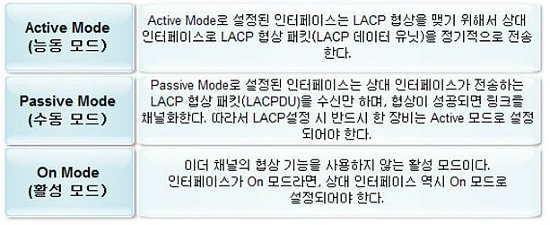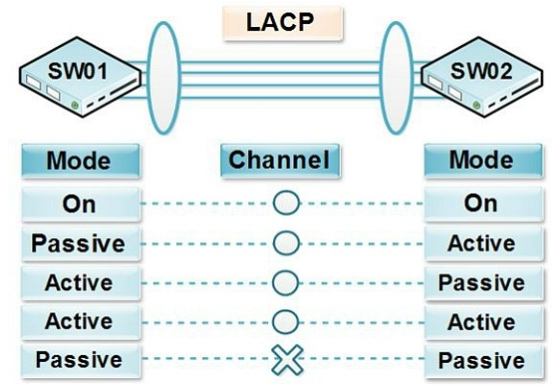Linux bond/team 본딩/티밍 차이
| 기능 | Bonding | Team |
|---|---|---|
| broadcast Tx policy | Yes | Yes |
| round-robin Tx policy | Yes | Yes |
| active-backup Tx policy | Yes | Yes |
| LACP (802.3ad) support | Yes (active only) | Yes |
| Hash-based Tx policy | Yes | Yes |
| User can set hash function | No | Yes |
| Tx load-balancing support (TLB) | Yes | Yes |
| LACP hash port select | Yes | Yes |
| load-balancing for LACP support | No | Yes |
| Ethtool link monitoring | Yes | Yes |
| ARP link monitoring | Yes | Yes |
| NS/NA (IPv6) link monitoring | No | Yes |
| ports up/down delays | Yes | Yes |
| port priorities and stickiness (“primary” option enhancement) | No | Yes |
| separate per-port link monitoring setup | No | Yes |
| multiple link monitoring setup | Limited | Yes |
| lockless Tx/Rx path | No (rwlock) | Yes (RCU) |
| VLAN support | Yes | Yes |
| user-space runtime control | Limited | Full |
| Logic in user-space | No | Yes |
| Extensibility | Hard | Easy |
| Modular design | No | Yes |
| Performance overhead | Low | Very Low |
| D-Bus interface | No | Yes |
| multiple device stacking | Yes | Yes |
| zero config using LLDP | No | (in planning) |
| NetworkManager support | Yes | Yes |
Bond 와 Team 에서의 LACP 구현비교
Link Aggregation 이란?
단일 스위치의 물리적인 포트 여러개를 하나의 논리적인 포트로 만들어 줌으로써 대역폭을 늘리는 것을 말함(향상)
cisco에서는 Ether Channel이라고 불린다.
LACP Mode
설정시 주의할점
Linux bonding vs teaming for LACP
- LACP는 반드시 어느 한쪽이 Active 모드를 지원해야 한다.
bond는 Passive 모드만 지원한다.team은 Active 모드를 지원한다.- 따라서 스위치가 Active모드를 지원하지 않으면 bond로는 LACP를 구현할수 없다.
Passive mode는 트래픽 상태나 스위치에 상관없이 균등하게 로드밸런싱을 한다.Active mode는 트래픽 상태나 스위치의 상태에 따라 트래픽을 조절한다.
언뜻 보기엔 Active mode가 더 좋아보이지만 일반적으로 Active mode는 부하조절을 위한 오버헤드가 발생하므로 속도가 낮아지는 경향이 있다.
이때문에 종종 대용량 트래픽이 발생하는 곳에서는 Passive mode를 사용하기도 한다.

